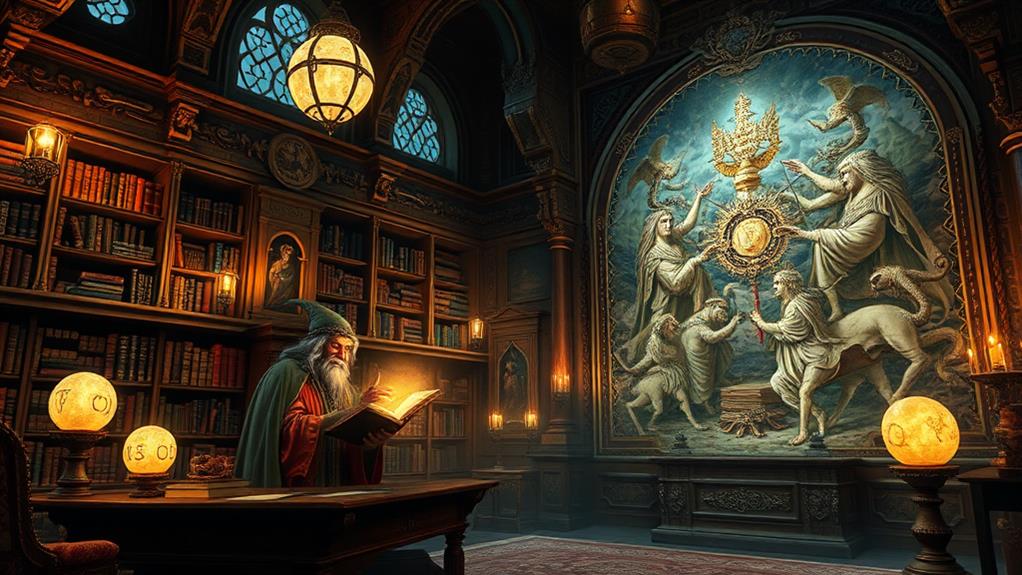
Magical artifacts are essential to wizarding history because they shape pivotal moments and enrich cultural heritage. You find that ancient civilizations created powerful relics for protection, power, and wisdom. Legendary artifacts like the Elder Wand or Philosopher's Stone define key events and magical advancements. These items, often deeply rooted in historical battles and educational traditions, reveal the ingenuity and peril of the wizarding world. They also demand preservation to guarantee safety and continuity for future generations. By exploring these artifacts, you'll gain a deeper appreciation for the magical world's complexities and rich history.
Ancient Origins of Artifacts
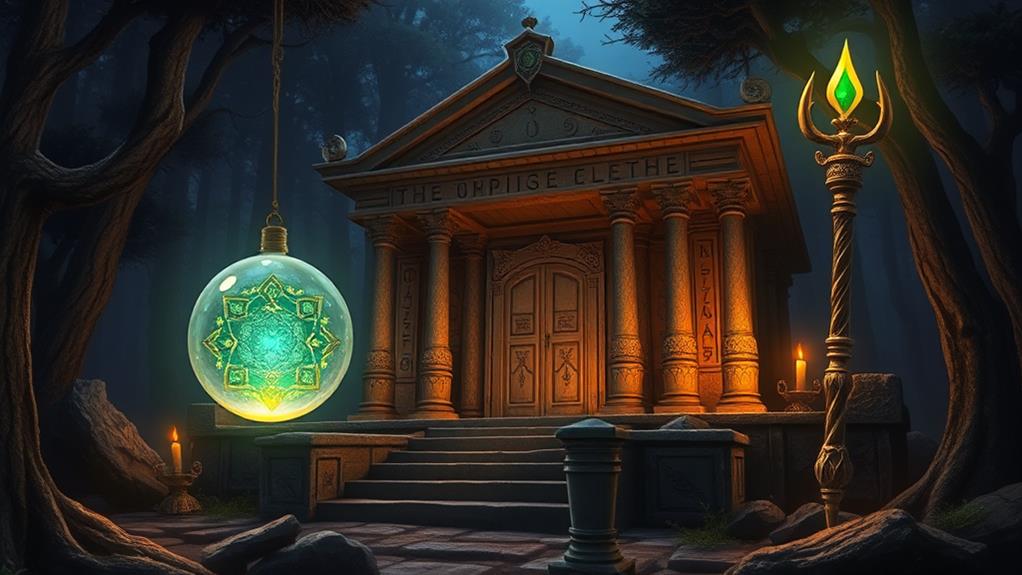
The ancient origins of magical artifacts are shrouded in mystery and legend, enchanting the imagination of wizards and witches for centuries. You can trace these artifacts back to times when magic was raw and untamed, flowing through the world in ways modern sorcerers can barely comprehend. Scholars believe that ancient civilizations like Atlantis and Mesopotamia were the cradles of these powerful relics, crafted by the most skilled enchanters of their era.
As you explore this arcane history, you'll discover that these artifacts were often created for specific purposes, whether to protect, heal, or wield incredible power. For example, talismans were commonly used to safeguard against dark forces, while ancient staffs and wands served as conduits for channeling raw magical energy. You might find it fascinating that even mundane objects, once imbued with magical properties, could become legendary tools of great import.
Understanding the creation and early use of these artifacts provides you with a richer appreciation of their role in wizarding history. By examining ancient texts and archaeological findings, you'll gain insight into the lives and practices of early magic users, revealing a world where the boundaries between the magical and the mundane were fluid and ever-changing.
Legendary Artifacts and Their Powers
Among the most enthralling elements of wizarding history are the legendary artifacts and the astonishing powers they possess. These ancient objects aren't just relics; they're imbued with extraordinary abilities that have shaped the course of magic itself.
Let's explore three of the most famed artifacts:
- The Elder Wand: Known as the most powerful wand ever created, it has a history of unparalleled magical feats. It's said that the wand chooses the wizard, but in the case of the Elder Wand, its allegiance shifts to the one who conquers its previous master.
- The Philosopher's Stone: This stone can grant immortality and turn any metal into pure gold. Created by Nicolas Flamel, it represents the pinnacle of alchemical achievement and has been the subject of countless quests and legends.
- The Invisibility Cloak: Unlike ordinary invisibility cloaks that wear out over time, this one, passed down from generation to generation in the Potter family, renders its wearer completely undetectable and is impervious to spells that typically reveal hidden objects.
These artifacts, with their unique powers, highlight the ingenuity and mystery that define wizarding history. They’re not just tools but emblems of the magical world’s rich and complex heritage. Throughout the ages, magical artifacts in wizardry have served various purposes, from enhancing spells to providing protection against dark forces. Each artifact carries with it a story, often linked to legendary wizards and their remarkable journeys, thereby enriching the lore of the magical community. As students and scholars delve into the study of these treasures, they uncover not only practical applications but also deep philosophical questions about power and responsibility in the wizarding realm.
Historical Battles and Artifacts
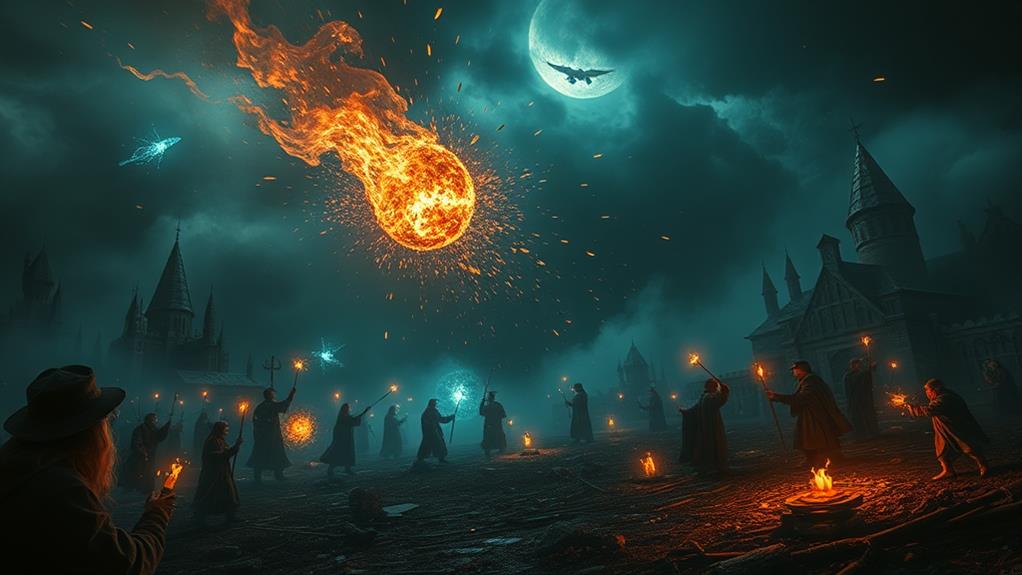
While legendary artifacts have left an indelible mark on wizarding history, their influence shines brightest in the heat of battle. Imagine yourself standing on a battlefield where the clash of spells fills the air. In such moments, artifacts like the Elder Wand or the Sword of Gryffindor become game-changers. They don't just tip the scales; they redefine them.
Consider the Battle of Hogwarts. When wielded by a true master, the Elder Wand turned the tide against the forces of darkness. It wasn't just a wand; it was a symbol of resistance and hope. The Sword of Gryffindor, with its goblin-made brilliance, appeared to those most in need, slicing through enemies and enchantments alike.
Think about the First Wizarding War. The Resurrection Stone, though often seen as a cursed object, played a pivotal role in the Order of the Phoenix's strategy. It allowed fallen comrades to share invaluable intelligence, turning despair into tactical advantage.
You can't ignore these artifacts' roles in shaping outcomes. They're not mere tools; they're catalysts for victory. By understanding their historical significance, you grasp why magical artifacts are so essential to wizarding history, especially in the crucible of conflict.
Artifacts in Wizarding Education
In the domain of wizarding education, magical artifacts aren't just relics of the past—they're indispensable teaching tools that bring enchantments to life. Imagine learning about ancient runes without ever touching a real enchanted stone or studying potion-making without the aid of an ever-boiling cauldron. These artifacts create immersive experiences that textbooks simply can't match.
For students and educators alike, incorporating magical artifacts into the curriculum makes lessons more engaging and memorable. Here are three ways they enhance wizarding education:
- Hands-on Learning: Artifacts like the Pensieve allow students to experience historical events firsthand, providing a deeper understanding than any lecture could offer.
- Skill Development: Using items like enchanted quills helps students practice spellwork with immediate feedback, improving their magical dexterity and precision.
- Cultural Appreciation: Artifacts like the Goblet of Fire teach students about the significance of magical traditions, fostering a respect for wizarding heritage.
Famous Wizards and Their Artifacts
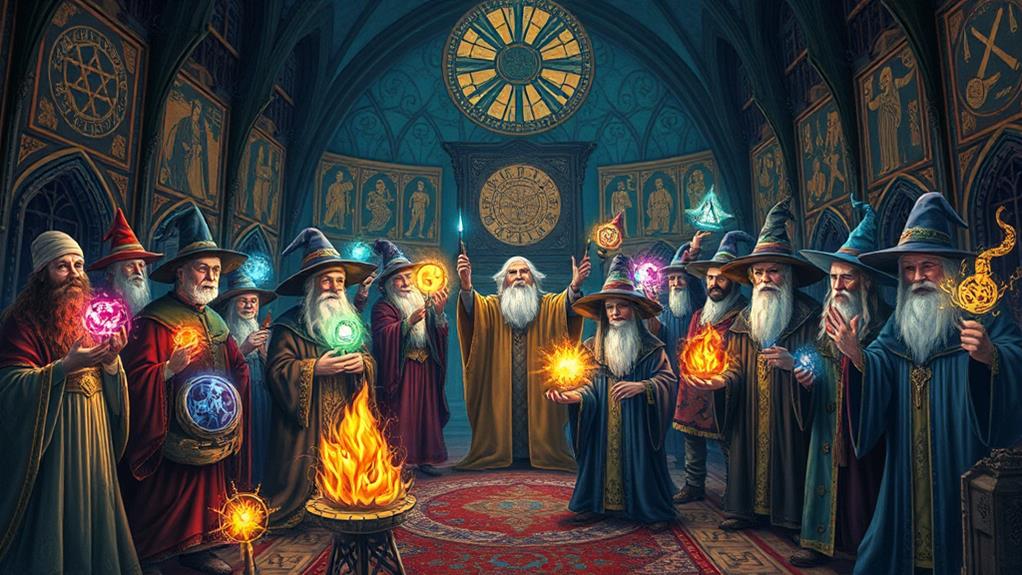
Throughout wizarding history, certain wizards have become legendary not just for their magical prowess but also for the artifacts they wielded. Take, for instance, Godric Gryffindor and his famed sword. This goblin-made weapon, imbued with powerful enchantments, has been a symbol of bravery and valor for centuries. You can't forget about Albus Dumbledore and the Elder Wand, either. Known as the most powerful wand in existence, it played a vital role in many pivotal moments in wizarding history.
Then there's Rowena Ravenclaw, whose diadem was said to enhance the wisdom of its wearer. Though lost for many years, its legacy contributed greatly to her legend and the values of her house at Hogwarts. Don't overlook the Invisibility Cloak used by Harry Potter, either. This rare artifact, one of the Deathly Hallows, has roots deep in folklore and history, providing Harry with protection and anonymity.
These artifacts are more than just tools; they're extensions of the wizards themselves, amplifying their abilities and shaping their legacies. When you study these wizards, you see how their artifacts were integral to their stories and the broader tapestry of wizarding history.
Dark Arts and Cursed Objects
Explore the sinister domain of the Dark Arts, and you'll soon uncover a plethora of cursed objects that have wreaked havoc across wizarding history. These artifacts, imbued with dark magic, have caused untold suffering and chaos. As you dig deeper, you'll find that some items are more infamous than others, each with its own dark legacy.
- The Hand of Glory: This macabre object, often used by dark wizards, provides light only to its holder. It's said to be made from the hand of a hanged man, allowing criminals to navigate through darkness undetected.
- Tom Riddle's Diary: This seemingly innocent journal was a Horcrux, containing a fragment of Voldemort's soul. It manipulated and possessed those who wrote in it, nearly leading to Ginny Weasley's death and the reopening of the Chamber of Secrets.
- The Opal Necklace: Known for its deadly curse, this necklace has claimed the lives of at least nineteen Muggle owners. When worn, it causes unbearable pain and often death, making it one of the most feared cursed objects.
These cursed artifacts serve as grim reminders of the Dark Arts' perilous nature, emphasizing the need for constant vigilance.
Preservation of Magical Artifacts
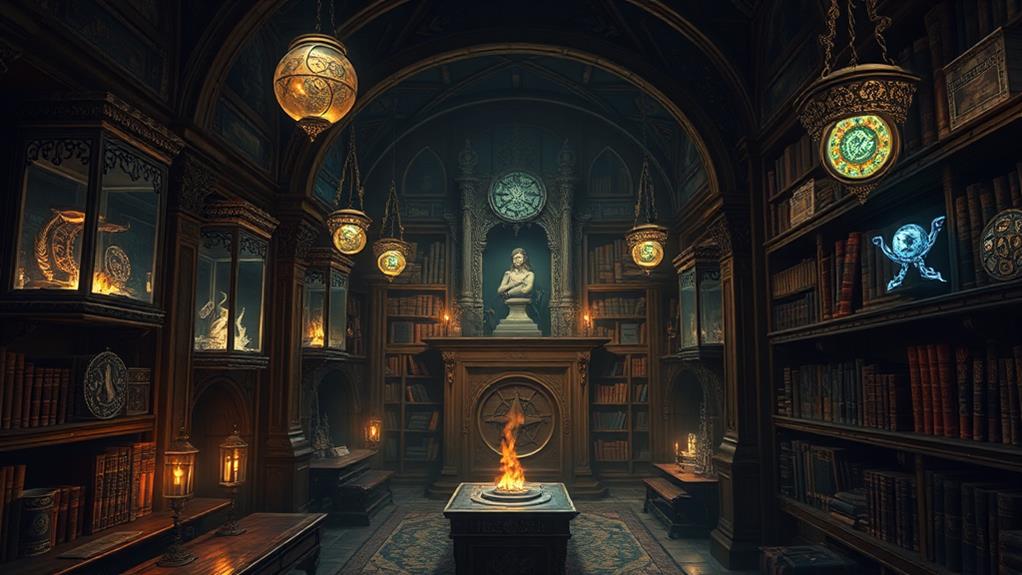
Safeguarding magical artifacts isn't just about preserving history; it's about protecting the wizarding world from potential peril. These items often hold immense power and can be dangerous if mishandled. By preserving them properly, you guarantee that their magic remains intact and doesn't fall into the wrong hands.
The preservation process involves several key steps:
| Step | Description |
|---|---|
| Identification | Determine the artifact's origin, history, and magical properties. |
| Containment | Use specialized containers or spells to prevent accidental activation. |
| Conservation | Regularly check for damage and perform necessary repairs using magical means. |
You need to understand the artifact thoroughly before you can store it safely. This means researching its background, magical capabilities, and any potential curses. Once you have this information, contain the item in a way that neutralizes its harmful effects. Specialized containers or protective spells are often employed for this purpose.
Regular conservation is vital. Magical artifacts can degrade over time, losing their potency or becoming unstable. Routine inspections and maintenance guarantee they remain in good condition. By following these steps, you not only preserve the artifact but also protect the wider wizarding community from unintended consequences.
Modern Day Artifact Discoveries
While preserving magical artifacts is fundamental to maintaining the wizarding world's safety, the discovery of new relics continues to captivate and challenge contemporary wizards. You might think that all significant artifacts have already been found, but recent years have proven otherwise. Today's discoveries not only offer a glimpse into the past but also present new opportunities and dangers.
When you hear about a new magical artifact being unearthed, it's not just an exciting headline. These discoveries often go through a meticulous process that involves:
- Initial Detection: Wizards use advanced spells and technologies to locate artifacts hidden in ancient ruins or enchanted forests.
- Examination and Authentication: Once found, artifacts undergo rigorous testing to verify their authenticity and magical properties. This guarantees they aren't cursed or dangerous.
- Preservation and Study: Finally, artifacts are preserved in secure facilities where experts can study their history, usage, and impact on modern magic.
At a Glance
You've seen how magical artifacts shape wizarding history, from ancient origins to modern discoveries. Delving into legendary powers and historical battles, you understand their immense impact. Famous wizards and cursed objects illustrate their dual nature. Some speculate artifacts possess a consciousness, influencing events beyond mere enchantments. While unproven, this theory adds depth to their significance. Preserving these artifacts guarantees future generations can reveal their secrets, continuing the legacy of mystery and magic.






